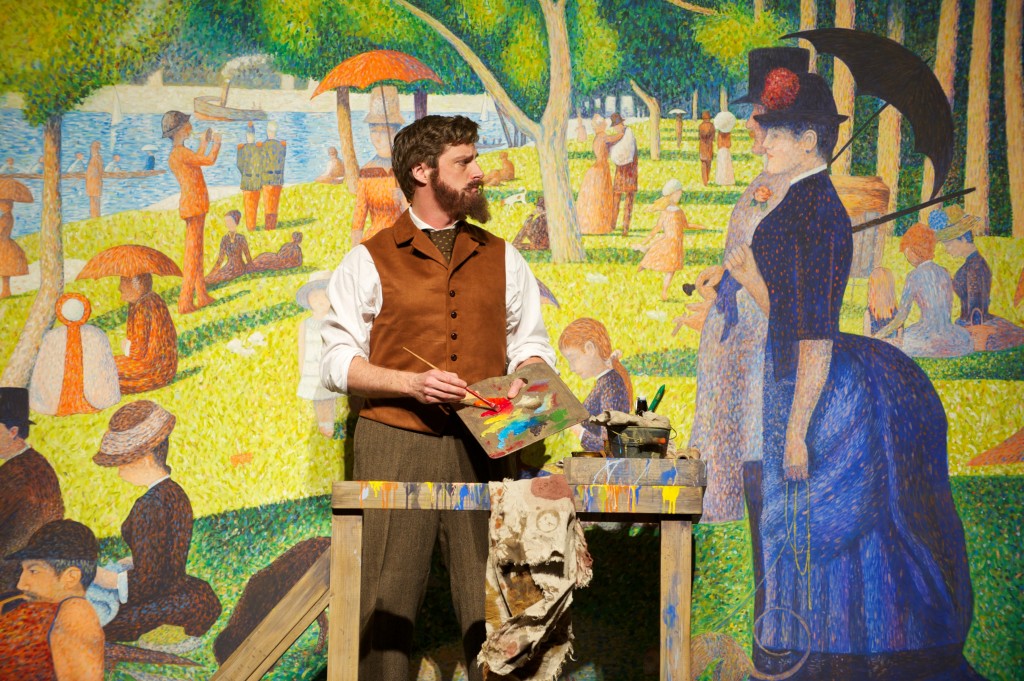Like repeated viewings of a famous work of art, the musical Sunday in the Park with George reveals more facets of the author’s/music director’s intent with each production. This may not be unusual, considering that the Tony Award-winning, Pulitzer Prize-winning Sundayis actually based on a famous work of art. The painting in question, “A Sunday Afternoon on the Island of La Grande Jatte” by Georges Seurat, hangs within the halls of nearby Chicago’s Art Institute.
Local productions of this famed musical are rare, given the show’s necessarily large budget. In this case, there is nothing to fear. The Skylight Music Theater, long known as Milwaukee’s preeminent producer of musicals, operas and works by Gilbert and Sullivan, has put its heart, soul and pocketbook into this show. This Sunday is touching, clever, spirit-lifting, and incredibly moving. In the second act, when a latter-day artist named George displays his laser light show, the performance is downright dazzling.
Set in Paris in the mid-1890s, the show initially focuses on the romance between Georges Seurat and his mistress, Dot. While Seurat faces a blank canvas, he announces his attempt to “bring order to the whole.” In the coming scenes, he will create something fresh, new and unexpected. Seurat’s inspiration is the human eye, which has a magical ability to “create” new colors by closely juxtaposing related colors. This practice, known as “pointillism,” creates a shimmering canvas of light and movement. As Seurat says, he is trying to make a “connection.” In his mind, this means the ability to “connect the dots” on a blank canvas. But in a larger sense, it is also about the connection between people.
While the troubled, moody Seurat is brilliant at creating his desired effect on canvas, he is miserable in his ability to maintain human relationships. A frosty mother doesn’t help.
Under the direction of Bill Theisen, Skylight’s artistic director, this production is revelatory in its ability to communicate the complicated relationship between Seurat and his mistress, Dot. She is a pretty, well-endowed young woman. The audience soon learns she cannot read and is endlessly fascinated by her image in a hand mirror. Dot understands that Seurat is different from any man she has ever met. She admires his manly physique as well as his talent. Ironically, Dot’s admiration for Seurat’s work is not universally shared by the art “establishment.” Artists – who will be long forgotten after Seurat has gained fame – a express misgivings about his work.
In one of the musical’s most important scenes, Dot drops by Seurat’s studio to announce that she and her fiancé, Louis the baker, are set to travel to America once her child is born. They both know that the child is Seurat’s. Seurat is infuriated by the news, to the point where he will not give Dot a painting as a memento of their relationship. Dot has to spell out the words she longs to hear from Seurat in order to change her plans. When he fails to respond, the die is cast.
Although Dot is convinced that she and Seurat will share a bond that time cannot erase, it is about 100 years later that her intuition comes true. In act II, set in the 1980s, she reaches out across the generations to create an unlikely bond with Seurat’s great-grandson, also an artist named George.
Theisen excels at illustrating how destructive Seurat’s single-minded passion can be. By shutting himself off from the world, Seurat cannot enjoy the recognition that is deservedly his. Actor Sean Allan Krill, who plays Georges Seurat in Act I and his descendant, also an artist named George, in Act II, bridges the gap between the generations with utmost skill. As Georges, he conveys genuine feelings for Dot, played by Alison Mary Forbes. He is tormented by the thought of losing Dot, although knowing that he cannot keep her in a way that would make her happy.
As one would expect at this music-oriented theater company, the voices are all top-notch. This skill is not limited to the principals. Everyone onstage has a better-than-average voice. Although the characters in the painting also develop into minor roles, they are rarely fleshed-out enough for critical attention. Despite this fact, one must note that Robb Smith has made the most convincing Boatman this reviewer has ever seen. Other notable performances include Marilyn White as a grumpy old lady, who turns out to be Georges’ mother, and Bryce Lord as the impeccably attired artist, Jules. The characters’ personalities and voices come together winningly in the Act II opener, “It’s Hot Up Here.”
One cannot complete a review of this production without noting the small but hard-working orchestra, under Richard Carsey’s direction. They add precisely the right amount of volume to complement the actors’ voices. Costumes are an important component of Sunday’s success as well, and Shima Orens has created the desired visual effect. The large stage is kept deliberately sparse by Van Santvoord, in order to let the painting’s numerous characters fill the void. The set glows with iridescent colors, especially enhanced by lighting effects on the water.
Watching Sunday in the Park is a perfect way for theatergoers to spend a Sunday – or any other day of the week, for that matter.


